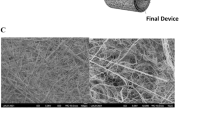Abstract
The antiadhesive properties and biocompatibility of porous and nonporous films based on branched polyvinyl alcohol were evaluated. A nonporous film of branched polyvinyl alcohol has been shown to preserve the intestinal epithelium and cause only slight inflammation and edema. On the contrary, implantation of a porous film induced fibrin formation and severe inflammation and ensured only focal preservation of the intestinal epithelium.





Similar content being viewed by others
REFERENCES
N. Alexandre, J. Ribeiro, A. Gartner, et al., “Biocompatibility and hemocompatibility of polyvinyl alcohol hydrogel used for vascular grafting-in vitro and in vivo studies,” J. Biomed. Mater. Res. A 102, 4262–4275 (2014).
M. V. Semenova, S. V. Osadchenko, Ya. O. Mezhuev, et al., “Synthesis of hemocompatible materials based on branched polyvinyl alcohol,” Russ. J. Appl. Chem. 89, 1286–1291 (2016).
Ya. O. Mezhuev, M. V. Sten’kina, S. V. Osadchenko, and M. I. Shtil’man, “Production and kinetics of swelling in water of biocompatible branched polyvinyl alcohol films,” Russ. J. Appl. Chem. 93, 176–181 (2020).
S. K. Vineeth, R. V. Gadhave, and P. T. Gadekar, “Glyoxal cross-linked polyvinyl alcoholmicrocrystalline cellulose blend as wood adhesive with enhanced mechanical, thermal and performance properties,” Mat. Int. 2, 0277–0285 (2020).
R. Parhi, “Cross-linked hydrogel for pharmaceutical applications: a review,” Adv. Pharm. Bull. 7, 515–530 (2017).
T. Liu, C. Jiao, X. Peng, et al., “Super-strong and tough poly(vinyl alcohol)/poly(acrylic acid) hydrogels reinforced by hydrogen bonding,” J. Mater. Chem. B 6, 8105–8114 (2018).
S.-A. Riyajan and Y. Sasithornsonti, “Chemical crosslink degradable PVA aqueous solution by potassium persulphate,” J. Polym. Environ. 21, 472–478 (2012).
C.-L. Lai, J.-T. Chen, Y.-J. Fu, et al., “Bio-inspired cross-linking with borate for enhancing gas-barrier properties of poly(vinyl alcohol) / graphene oxide composite films,” Carbon 82, 513–522 (2015).
L. Su and G. Fang, “Characterization of cross-linked alkaline lignin/poly(vinyl alcohol) film with a formaldehyde cross-linker,” BioRes 9, 4477–4488 (2014).
R. Rudra, V. Kumar, and P. P. Kundu, “Acid catalysed cross-linking of poly vinyl alcohol (PVA) by glutaraldehyde: effect of crosslink density on the characteristics of PVA membranes used in single chambered microbial fuel cells,” RSC Adv. 5, 83436–83447 (2015).
M. Abu Ghalia and Y. Dahman, “Radiation crosslinking polymerization of poly (vinyl alcohol) and poly (ethylene glycol) with controlled drug release,” J. Polym. Res. 22, 218 (2015).
W. Wan, A. D. Bannerman, L. Yang, and H. Mak, “Poly(vinyl alcohol) cryogels for biomedical applications,” Adv. Polym. Sci. 263, 283–321 (2014).
A. Suzuki and S. Sasaki, “Swelling and mechanical properties of physically crosslinked poly(vinyl alcohol) hydrogels,” Proc. Inst. Mech. Eng. 229, 828–44.
T. Ren, J. Gan, L. Zhou, and H. Chen, “physically crosslinked hydrogels based on poly (vinyl alcohol) and fish gelatin for wound dressing application: fabrication and characterization,” Polymers 12, 1729 (2020).
I. M. Garnica-Palafox, F. M. Sanchez-Arevalo, C. Velasquillo, et al., “Mechanical and structural response of a hybrid hydrogel based on chitosan and poly (vinyl alcohol) cross-linked with epichlorohydrin for potential use in tissue engineering,” J. Biomater. Sci. Polym. Ed. 25, 32–50 (2014).
M. V. Semenova, Ya. O. Mezhuev, S. V. Osadchenko, and M. I. Shtil’man, “Kinetic features of the reaction of polyvinyl alcohol with epichlorohydrin in an alkaline medium,” Russ. J. Gen. Chem. 87, 1047–1052 (2017).
Funding
The work was carried out with the financial support of the Ministry of Science and Higher Education of the Russian Federation within the framework of a state order, project no. FSSM-2020-0004.
Author information
Authors and Affiliations
Corresponding author
Additional information
Translated by M. Drozdova
Rights and permissions
About this article
Cite this article
Osadchenko, S.V., Sten’kina, M.V., Mezhuev, Y.O. et al. A New Biocompatible Release Material Based on Branched Polyvinyl Alcohol. Polym. Sci. Ser. D 15, 436–440 (2022). https://doi.org/10.1134/S1995421222030200
Received:
Revised:
Accepted:
Published:
Issue Date:
DOI: https://doi.org/10.1134/S1995421222030200




